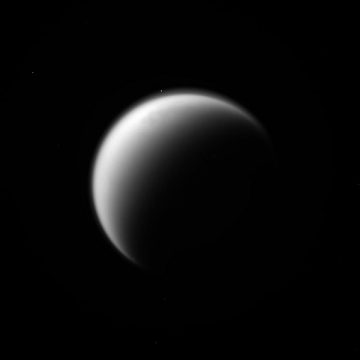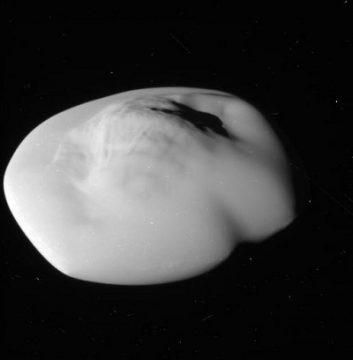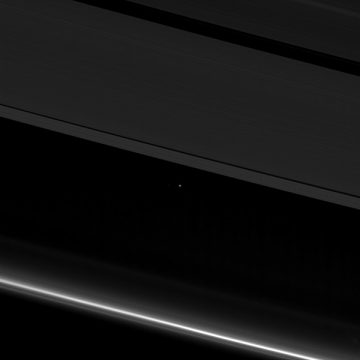Cassini's Grand Finale has begun, as the spacecraft threaded the needle between Saturn and its rings, following several fantastic moon passes and a final glance back at Earth.

NASA/JPL
NASA's Cassini spacecraft is a survivor. Launched in 1997, Cassini has given us an amazing ride, becoming the only mission to enter orbit around Saturn and explore the planet, its rings, and its system of moons in amazing, never-before-seen detail. Now, Cassini is astounding us once again, as it completed the first of 22 Grand Finale orbits this week, becoming the first mission to thread the gap between the planet and the inner edge of its rings.
Signal was reacquired by the worldwide Deep Space Network on Thursday, April 27, at about 2:56 a.m. EDT / 6:56 UT. Cassini went plunging through the ring plane “main dish first,” using the 4-meter diameter communications array as a debris shield. Cassini wasn't expected to encounter anything larger than smoke-sized particles, but as the spacecraft is moving at 77,000 mph relative to Saturn, anything much larger would pack quite a wallop, possibly disabling the spacecraft for good.
“No spacecraft has ever seen Saturn this close before,” says Earl Maize (NASA-JPL) in a recent press release. “We could only rely on predictions, based on our experience with Saturn's other rings. I am delighted to report that Cassini shot through the gap just as we planned and has come out the other side in great shape.”
Cassini passed just 1,900 miles (3,060 km) from the Saturnian cloud tops, as it crossed 200 miles (320 km) interior to the visible edge of the innermost D-ring. We'll see a pass once every week now, until final atmospheric entry and disposal for Cassini of September 15, 2017. Cassini's final farewell pass of Titan on April 22nd set it up on its current ballistic trajectory, meaning that even if the spacecraft is disabled, its final destruction burning up in the atmosphere of Saturn is assured.
Cassini also looked back at Titan one last time during its 127th and final close 608 mile (908 km) pass near the enigmatic shrouded moon:

NASA/JPL/Caltech/Space Science Institute
Cassini delivered the European Space Agency's Huygens lander to the surface of Titan on January 14, 2005, the most distant landing on another world by a human-built spacecraft to date.
Saturn, Close Up and Personal
The first raw closeup images of Saturn are simply amazing. Here, we see the dark "eye" of the polar hexagon and churning convection cells of Saturn's upper atmosphere. Cassini will sample Saturn's upper atmosphere on subsequent passes. It will also use its Radio and Plasma Wave Subsystem (RPWS) to sample the local density of particles in the ring plane. A series of radio occultation experiments will narrow down the overall mass estimate for Saturn's system of rings.

NASA / JPL / Space Science Institute
The ongoing series of Grand Finale orbits were preceded by a series of Ring Grazing Orbits, during which the spacecraft gave our best view yet of the strange moon Atlas, as Cassini passed 7,000 miles from the Moon on April 12th:

NASA / JPL / Space Science Institute
As suspected, Atlas resembles the ravioli-shaped moon Pan with ring material accumulating along its equator. Are all ring embedded moons this weird? Clearly, the bizarro-world shaped like a classic UFO straight out of Plan 9 From Outer Space is no random occurrence.
Cassini also looked back at its world of origin one last time on April 12th, glimpsing the distant Earth, the Moon and its spacecraft-building, ape-descendant creators through a gap in Saturn's rings one last time.
The Once and Future Saturn

NASA/JPL/Space Science Institute
We're coming up on a great season for Earthbound star parties to look back at Saturn as well, as the planet reaches opposition in the constellation Ophiuchus on June 15th. Saturn's rings are tilted at the widest (27°) they can be seen from Earth in 2017, something that only occurs for alternating hemispheres of Saturn once every 14 to 15 years.
The end of Cassini marks the start of a series of finales: next up, NASA's Dawn mission wraps up exploration at Ceres in late 2017. Then Juno will finish up at Jupiter, taking an atmospheric plunge in mid-2018. Then, New Horizons will make a New Year's Day 2019 pass near Kuiper Belt Object 2014 MU69.
Like the Pioneer and Voyager spacecraft, also escaping the solar system, we'll likely still hear from New Horizons for years to come.But sad to say, our eyes in the outer solar system are due to go dark in the coming years, as the next outer solar system missions aren't slated until the late 2020s . . . that is, if NASA's Europa mission and the Lucy mission to Jupiter's Trojan asteroids can survive the financial waves of numerous future administrations.
Enjoy the thrill ride provided by Cassini and friends now, while you still can.
 1
1









Comments
Margarita
April 28, 2017 at 4:31 pm
There's also the European Space Agency's JUICE mission.
http://sci.esa.int/juice/58887-esa-s-jupiter-mission-moves-off-the-drawing-board/
"The JUpiter ICy moons Explorer (JUICE) is an interplanetary spacecraft in development by the European Space Agency (ESA) with Airbus Defence and Space as the main contractor. The mission is being developed to visit the Jovian system focused on studying three of Jupiter's Galilean moons: Ganymede, Callisto, and Europa (excluding the more volcanically active Io) all of which are thought to have significant bodies of liquid water beneath their surfaces, making them potentially habitable environments.[3] The spacecraft is set for launch in 2022 and would reach Jupiter in 2030. By 2033 the spacecraft should enter orbit around Ganymede for its close up science mission and becoming the first spacecraft to orbit a moon other than the moon of Earth. The selection of this mission for the L1 launch slot of ESA's Cosmic Vision science programme was announced on 2 May 2012."
https://en.wikipedia.org/wiki/Jupiter_Icy_Moons_Explorer
Wikipedia notes that "For the similarly-named cancelled NASA concept, see Jupiter Icy Moons Orbiter." So it is important not to confuse the two missions: ESA's mission to the Jovian system seems firmly on target.
You must be logged in to post a comment.
You must be logged in to post a comment.